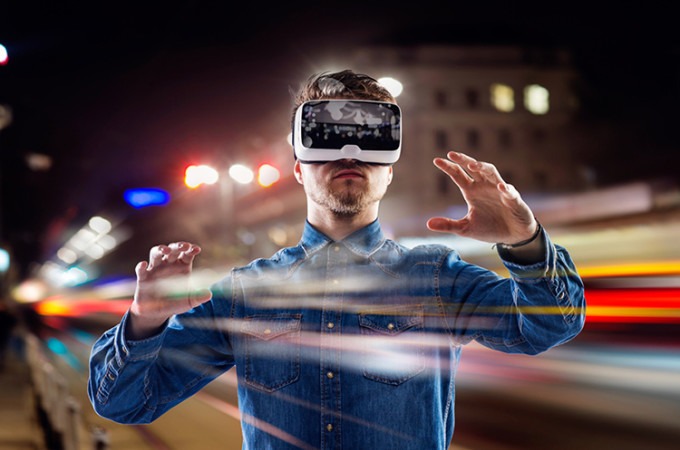The promise of virtual reality technology — long anticipated as the “wave of the future” — looks to finally be paying off. Consumer products like the Oculus Rift are combining ever-more-seamless virtual reality experiences with more accessible price points, and even video game consoles have been using motion-detection technology for several years to create an immersive, “you are there” experience.
Virtual reality for engineering is also reaching new levels of utility and access. The ability to install full-room configurations — like a cave automatic virtual environment (CAVE) — at a reasonable cost means that these systems are being found in more and more facilities, for uses like walkthroughs and presentations — as well as collaboration during the development phase. What’s more, virtual reality headsets are proving ever more useful to engineers working with individual components, parts and product concepts.
What are some other uses of virtual reality in engineering — and its benefits? Read on to learn more.
Cost savings. A full-room setup like a CAVE certainly doesn’t come without a significant investment. The potential benefits, however, can surely justify that cost — and can even pay the money back. While virtual reality shouldn’t replace physical prototyping, it can assist with some of the benefits of prototyping — and can even fill in for some of its early stages.
Virtual reality can allow engineers to manipulate a component as they would in the real world: For instance, checking for fit and compatibility with the overall product. Engineers can also manipulate tolerances and dimensions in a virtual reality environment, checking to see how certain setups would change the output of a process like plastic injection molding.
Conducting these early design tests costs almost nothing and can replace the need for some initial prototypes that may be more of a “trial-and-error” consideration, for instance, where designers and engineers are trying to zero in on just the right construction. Forgoing the need for these prototypes can result in significantly lower overall development costs.

Plus, even if installing a dedicated CAVE is out of the question for your facility, you may be able to rent or lease CAVE time from another facility in your area, or from a business that offers a dedicated rental service.
Manufacturability testing. For more complex parts, working with a fully immersive virtual reality model can tell a much more complete story than even CAD modeling can. By coming that much closer to the actual tactile experience of handling a component and installing it in an existing configuration, engineers can make a much more accurate determination of the requirements of a part, and how it should be manufactured.
Design benefits. Design engineers can benefit from virtual reality for several of the same manufacturability reasons mentioned above. Working in a true 3D space for design offers a number of other benefits as well. Rather than having to design a 3D object in the 2D environment of most of today’s modeling software, design engineers will be able to use virtual reality to have a much more accurate experience of creating a part or component as it actually will appear, rather than simply a 2D representation. As the engineers of the future — those not already well versed in SOLIDWORKS or other software — grow even more accustomed to the potential of virtual reality as a design method, its benefits will only continue to expand.
Collaboration. Full-room CAVE setups take virtual reality out of the headset and create a shared virtual environment — one where designers, engineers, QA, and any and all other stakeholders and functions can work together in real space and real time to create better products. A CAVE setup is essentially a “cube” (or a room), where either half or all of the walls have the virtual reality environment projected onto them, in extreme high definition (4K is currently the technology of choice).

Virtual reality has reached a point where it truly does feel immersive — the human brain is very conscious of false attempts at reality, which is why the technology has taken so long to become mainstream and effective. “Simulated reality” just isn’t the same. With companies like Ford investing big dollars in the technology, it’s clear that buy-in is occurring and that the technology is working as has long been hoped it would.
So in a CAVE setup, there’s none of the uncanniness or adjustment time that would normally detract from a virtual reality experience. No one isn’t going to “get it” or be unable to focus on the task at hand — anyone and everyone is able to walk into the environment and get to work. Whether it’s conducting product demos, troubleshooting a problem, or trying to fix a mechanical, electrical or other physical issue, the collaboration experience offered by CAVE virtual reality offers huge benefits. These include:
- • Cost savings — for the reasons mentioned above.
- • Time savings — no need to wait for one-off part runs or physical models to be created.
- • Safety — employees are not working with moving parts, live electricity or other potential hazards that exist in the everyday operation of a facility.
- • Creativity — brainstorming potential solutions to problems is not limited by cost or time constraints, and conducting a full test for an idea is as simple as changing a few lines of code.
Presentation. Entrepreneurs no longer need to rely on a PowerPoint deck to pitch to investors, and design engineers and other creative functions no longer need to put faith in a cognitive leap from their audience when describing new designs and concepts. Virtual reality — whether full room or in a headset — offers an unprecedented way to share the full experience and potential of your product or design with potential investors, colleagues and management stakeholders.
While virtual reality can’t and shouldn’t replace all of the physical aspects of manufacturing — after all, you wouldn’t want the first physical manifestation of your product to occur as a production run — it offers numerous benefits in engineering, as you’ve seen here. By freeing development costs, enabling greater creativity, and fostering collaboration, it opens new possibilities for innovation in the ever-evolving world of manufacturing.



